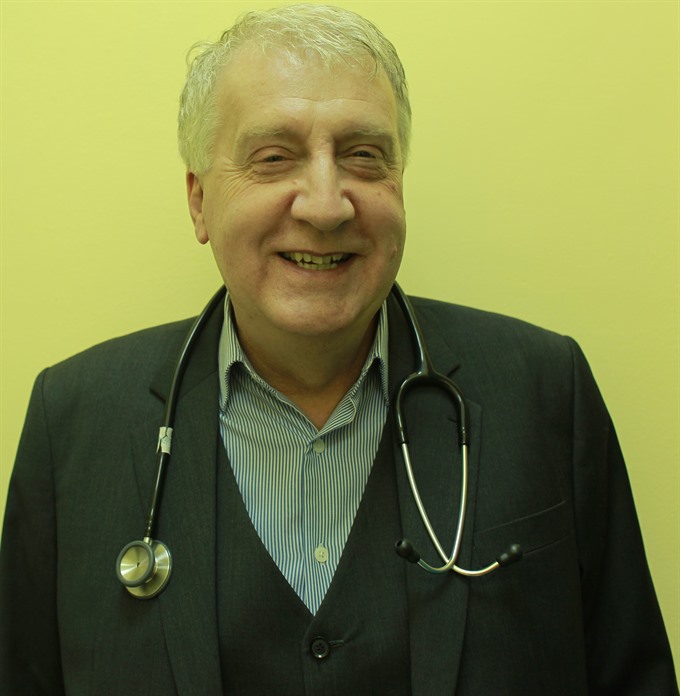 Life & Style
Life & Style

World Hepatitis Day falls on July 28. Hepatitis B is a matter of concern in Việt Nam, with at least 5 per cent of the population infected. Most people have heard of Hepatitis A&B, but not everyone knows that there is also Hepatitis C, D, and E. While A&B can be prevented by vaccination, the other three cannot.
 |
| Doctor William Brian McNaull. — Photo Courtesy of Family Medical Practice Hanoi |
Although there are variations in the symptoms between the different viral liver infections, the following signs and symptoms generally occur in all acute infections:
Fever, fatigue, loss of appetite, nausea, vomiting accompanied by abdominal pain, dark urine, clay-colored bowel movements, joint pain and jaundice.
Incubation period averages 28 days. Mortality is <0.1 in child/teenage years but 2% over 40 years old. Hepatitis A is usually spread when the virus is taken in by mouth from contact with objects, food, or drinks contaminated by the feces (or stool) of an infected person. A person can get Hepatitis A through:
Person to person contact: when an infected person does not wash his or her hands properly after going to the bathroom and touches other objects or food. Contaminated food or water: Hepatitis A can be spread by eating or drinking food or water contaminated with the virus. Poor sanitary conditions or poor personal hygiene exacerbate the spread. The food and drinks most likely to be contaminated are fruits, vegetables, shellfish, ice, and water. Chlorination of water kills Hepatitis A virus that enters the water supply.
Vaccine available.
Incubation period averages 90 days. Acute infection mortality is < 1%. There are 2 major modes of transmission of HBV [i] transmission through activities that involve percutaneous (i.e., puncture through the skin e.g. injection drug use that involves sharing needles, syringes, or drug-preparation equipment. Needle sticks or sharp instrument exposures or even sharing items such as razors with an infected person. [ii] Mucosal contact with infectious blood or body fluids (e.g., semen, saliva), including sex with an infected partner, birth to an infected mother.
In Viet Nam this is a very important disease with between 5 and 10% of the population being actual ‘carriers’ of the disease. For nearly all Vietnamese affected, it is mucosal contact (saliva) which is the mode of transmission, occurring at an early age or at birth from an infected mother. Usually no symptoms are present when the disease is acquired before puberty but nearly all become chronic carriers.
Hepatitis B is acquired principally in the ‘developed’ countries as an STD resulting in severe symptoms initially, but total immunity develops upon recovery, usually. Chronic infection may have significant consequences for the individual (Cirrhosis, liver failure and /or liver cancer [HCC]) There are 350 million persons infected worldwide. An estimated 620,000 persons worldwide die of chronic-HBV related liver diseases each year.
Vaccine available.
Incubation period averages 55 days (range 4-12 weeks). Mortality is rare from acute infection. Perhaps the most ‘talked about’ hepatitis in the West is Hepatitis C. About 15-20% of acute infection resolves spontaneously, the remainder go on to be chronic carriers of the disease with consequences ranging from mild sequelae to very severe (Cirrhosis, liver failure, cancer).
The following persons are at known to be at increased risk for HCV infection: Current or former injection drug users, including those who injected only once many years ago and cocaine ‘snorters’. Recipients of blood transfusions/clotting factors or solid organ transplants before July 1992, when better testing of blood donors became available. Chronic hemodialysis patients. Persons with HIV infection have increased risk of co-infection. History of tattoos should also be considered. Children born to HCV-positive mothers have about a 6% chance of transmission at birth.
No vaccine available.
Hepatitis D – Chronic infection mainly
Also known as "delta hepatitis". This is a serious liver disease caused by infection with the Hepatitis D virus (HDV), which is structurally unrelated to the Hepatitis A, B or C viruses. Hepatitis D, which can be acute or chronic, is uncommon in most parts of the world. HDV is an incomplete virus that requires the helper function of HBV to replicate and only occurs among people who are infected with the Hepatitis B virus (HBV). HDV is transmitted through percutaneous or mucosal contact with infectious blood and can be acquired either as a co-infection with HBV or as super-infection in persons with HBV infection. So you need to have B already to get D.
No vaccine for Hepatitis D (prevented in persons who are not already HBV-infected by Hepatitis B vaccination).
Symptoms on average occur 40 days after exposure. Mortality is <4 %. HEV infection usually results in a self-limited, acute illness. It is widespread in the developing world.
Hepatitis E virus is usually spread by the fecal-oral route. The most common source of infection is fecally contaminated drinking water.
No vaccine available .— Family Medical Practice Vietnam
*Doctor William Brian McNaull serves as Medical Director at Family Medical Practice Hanoi. He brings extensive experience to the practice.
For more advice on any medical topics, visit Family Medical Practice Hanoi on 298 I Kim Mã, Ba Đình, Tel: (024) 3843 0748 and hanoi@vietnammedicalpractice.com.
FMP’s downtown HCM City location is at Diamond Plaza, 34 Lê Duẩn, District 1; Other facilities are at: 95 Thảo Điền Street, District 2. Tel: (028) 38227848. E:hcmc@vietnammedicalpractice.com
FMP Danang is located at 96-98 Nguyễn Văn Linh Street, Hải Châu District, Đà Nẵng. Tel: (0236) 3582 699. E: danang@vietnammedicalpractice.com.




